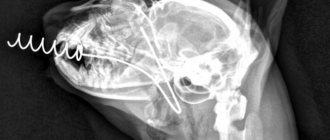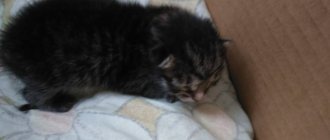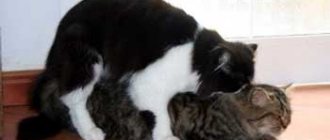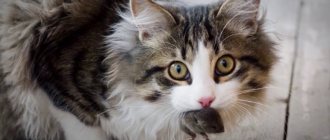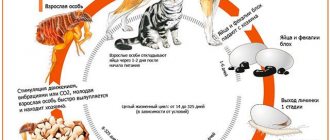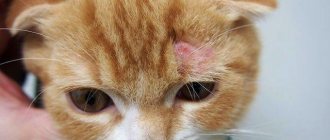Many cat and dog owners have at least once encountered an unpleasant situation when their pets needed help removing foreign bodies from the throat, intestines or from under the skin. You never know what will happen on your next walk. For example, glass, a needle or a splinter can get stuck between the paw pads, and some speck can get into the eye. In this case, situations most often arise in which urgent removal of a foreign body is required for a dog that has swallowed a ball, bone or other object.
Our advantages
Around the clock
Experienced doctors
Modern equipment
Hospital
Regardless of the situation, it is important not to hesitate, but to urgently take the necessary measures. It is not always possible to provide qualified assistance to your pet on your own, so it is better to contact an experienced veterinarian. Our clinic is located in the Babushkinskaya and Medvedkovo metro areas, so many Muscovites come to us, bringing cats, dogs and other pets for an appointment.
How can you tell if an animal has something stuck in its throat?
Practice shows that most often problems are associated with the fact that the animal swallows something. When a foreign object enters the oral cavity and remains there, the owner may notice excessive salivation, sometimes even with food particles or blood clots.
An unpleasant odor may appear from the mouth, and the cat or dog may begin to experience discomfort when chewing food. Some animals act more agitated than usual. If the situation is not serious, the pet may turn its head, act restless and rub its muzzle on the ground.
Having noticed these symptoms, you need to take a closer look at the animal and try to understand what exactly happened. Also, do not postpone a visit to the veterinarian to remove a foreign body for a cat or dog if the following signs are detected:
- refusal to eat;
- vomit;
- the animal wheezes and clears its throat;
- the stool has become hard or the pet has stopped going to the toilet;
- the stomach is swollen;
- the pet became very lethargic.
All of the above signs indicate that a foreign object is most likely stuck in the internal organs, most often in the pharynx. When contacting a veterinarian, a specialist will conduct a thorough examination, take an x-ray and determine the size and location of the stuck object. After this, the appropriate method for removing the foreign body for your dog or cat will be selected.
Is a foreign body really dangerous?
Professional cat breeders and veterinary doctors say that the most common diagnosis is a foreign body in a cat’s stomach. Much less often, a foreign object is found in the ear canal, nasal passages or eyes of the animal.
While actively playing with various objects, small and older cats can swallow them. During surgical intervention, veterinarians discover caps from bottles of valerian, parts of children's construction sets, and debris left during construction. Needles, buttons, New Year's tinsel, and fishing gear can also be swallowed by a cat.
The risk group consists of small kittens, due to their natural curiosity, who try everything to their teeth. In addition, they lack certain experience in swallowing inedible objects. The risk zone includes animals that are bored at home without their owners for a long time, as well as long-haired cats (when licking, they swallow the hairs that form in the trichobeosars).
If a cat swallows a foreign body, it immediately develops dangerous conditions in the body. A foreign body in the stomach area can cause dehydration of the body due to eruptions of gastric contents, refusal to eat, disruption of the cardiovascular system (sharp needles or hooks penetrate through the layers of the stomach into the myocardial membrane).
In addition, the danger lies in damage to the walls of the digestive system (depending on the location of the foreign object), ulcerations as the object moves, necrotic processes and intussusceptions. A foreign particle swallowed by a cat provokes blockage of the intestinal lumen and further obstruction, rupture of the intestinal walls and the risk of developing peritonitis with a high probability of death.
Foreign objects in a cat’s ear are also dangerous. The cause may be plant particles, formed sulfur plugs, sand and soil particles, larvae of parasites and insects. In some cases, the presence of a foreign particle in the ear canal does not cause the pet any discomfort, but most often, against the background of damage to the integrity of the structures, an inflammatory process develops with the addition of secondary bacterial microflora.
Untimely detection of a foreign object in the ear can cause purulent otitis with further perforation of the eardrum and penetration of exudate into the membranes of the brain.
A foreign body in the upper respiratory tract (nose and nasal passages) is rarely diagnosed. The cause is a disturbance in the swallowing process. Various needles and sewing pins, pieces of wire, branches, stems and tree bark can get into the larynx.
A blood clot, the larvae of a gadfly, is also considered a foreign body in the respiratory tract. Against the background of the pathological process, inflammation may appear in the trachea, bronchi and pulmonary structures.
Removing foreign objects from the throat
If a foreign object is stuck in the animal's throat, the veterinarian will remove it using long tweezers or a forceps. To do this, the pet's jaws are fixed with a so-called yawner, which provides free access to the larynx. This procedure can only be carried out if the foreign body is not stuck too deep. After removing the object, the mouth is treated with an antiseptic composition - potassium permanganate or furatsilin solution.
The pet owner must be aware that untimely provision of veterinary care can lead to complications, including:
- emphysema;
- pneumothorax;
- pleurisy, etc.
Endoscopic removal of foreign objects is performed under general anesthesia. In some situations, a tracheotomy is required - surgical intervention with a tracheotube. This is the name of the instrument inserted into the dissected trachea. This method is usually used when a foreign object gets stuck in the lower parts of the bronchial tube.
Help yourself?
The biggest mistake most patients make is overconfidence that caseous plugs can be removed at home using improvised means. They use a whole arsenal of objects that are absolutely not intended for this: spoons, forks, toothpicks... At best, such amateur activities simply will not bring results, at worst, they will cause injury to the surface of the tonsils and provoke severe bleeding, swelling and inflammation! This will most likely be followed by a sore throat! Plus, if you press incorrectly with a hard object on the accumulation of pus, you can push it even further into the thickness of the tonsil.
Some people try to gargle, believing that gargling will bring relief. Yes, the feeling of discomfort in the throat temporarily passes, but the accumulations of pustules do not disappear, because the rinsing solution comes into contact only with the surface of the tonsils, and getting inside it is extremely problematic, or rather, impossible. Therefore, this method is also not effective.
The best method to get rid of traffic jams is to consult an otolaryngologist!
Features of removing foreign objects from the stomach and intestines
Removing a foreign body from a cat or dog's stomach or intestines is a more difficult task. Usually, specialists detect a foreign object by palpation. It is better not to do anything on your own, and laxatives or enemas can only worsen the situation.
If the examination reveals that there is a foreign object in the intestines or stomach, the pet will be sent for surgery. After it, the animal will need rest and a diet that excludes damage and injury to internal organs during the recovery period.
Tonsil plugs: causes
To find out the etiology of the occurrence of purulent accumulations in the tonsils, you need to understand what role the palatine tonsils play in the body.
The tonsils are an important organ of the human immune system, which is the first to stand in the way of bacteria and viruses that enter the body through the mouth. As soon as “strangers” reach the surface of the tonsils, they begin to intensify the production of leukocytes, which enter into battle with pathogenic microorganisms. As a result of such “battle actions”, dead leukocytes, bacteria, and epithelial remains accumulate in the lacunae of the tonsils. Over time, minerals accumulate here, and the contents of the lacunae begin to harden, forming caseous plugs.
The main cause of traffic jams is chronic tonsillitis. But they can also form in the palatine tonsils for various reasons:
- accumulation of staphylococci, streptococci, pneumococci and other bacteria;
- in people who have a weak immune system;
- frequent sore throats;
- the presence of herpes virus and fungi in the body;
- dental problems (caries);
- viral infections (flu, ARVI).
Each of the above reasons can provoke inflammation of the tonsils. The risk of accumulation of caseous masses in the lacunae of the tonsils is increased by unhealthy diet, smoking, and alcohol consumption.
Traffic jams do not form just like that, for no reason. They are a consequence of another disease and signal that an inflammatory process is underway in the body.
Removing splinters after a walk
During walks, especially in parks or in the forest, as well as in littered areas, the animal can drive splinters into itself - wood or metal, and can even get glass deep under the skin.
Usually in such situations the pads are damaged. Splinters cause pain or discomfort, and if nothing is done in a timely manner, the onset of suppuration is possible. A cat or dog with a splinter begins to lick the sore spot, limps and tries to remove the foreign object with its teeth, but usually nothing works.
If the splinter is visible, you can try to remove it yourself with clean tweezers, but you will need an assistant to hold the cat or dog. After extraction, the wound is treated with iodine and bandaged. Our clinic’s veterinarians act in a similar way, but if necessary, they put the animal under anesthesia and use more complex instruments.
Preventive measures
For prevention purposes, you should follow the following rules:
- give the animal fish without small bones;
- do not feed chicken bones;
- use food based on age, for example, buy small dry food for kittens;
- Finely chop the meat for small kittens, do not leave large pieces near them for an adult cat.
Cats, just like people, can choke easily. Their digestive tract is quite thin and easily susceptible to mechanical damage. The pathological condition can be caused by grass, wool, fish products, and small children's toys. If a cat has a bone stuck in its throat, every owner should know what to do and what conditions to observe.
Removing foreign bodies from the eyes
During active walks, debris, dust and other contaminants get on the mucous membranes of the eyes, causing discomfort. The mucous membrane becomes irritated, and the cat or dog feels pain or stinging in the eyes. This can be understood by several characteristic features. First of all, the pet begins to constantly rub its eyes with its paws, and they also turn red and profuse tearing appears.
As first aid, you can rinse your eyes with saline solution or at least boiled water. Removing a foreign object from the eye yourself can be a dangerous task, so it is better to bring your pet to our clinic.
The specialist will carefully pull back the eyelid, and then use a syringe to pour in a special liquid for disinfection. The foreign body can be removed with a swab or a piece of bandage, and sometimes even tweezers are used. The main thing is not to put off a visit to the veterinarian, because if the animal rubs the eye for a long time, the speck will damage the mucous membrane. The damage may be irreversible.
By contacting Irina Onyshchuk’s veterinary clinic, you can be sure that experienced veterinarians will take care of your pet. You can check the exact cost of a hospital with an intensive care unit from the administrator by calling +7. We work around the clock!
What to do if a cat chokes on a bone
The article was prepared with the support of specialists from the online store of goods for animals Zooservice.
What to do if a cat chokes on a bone
Every owner of a four-legged friend should be prepared for any surprises, including knowing what to do if the cat chokes on a bone. This most often occurs when animals are fed large, unprocessed pieces of food, or when fed hard, fragile foods. Kittens and young cats also often choke, as they greedily grab large pieces of food and quickly swallow them. The presence of bones in the diet, be they fish, chicken, or others, significantly increases the risk of such a danger.
How to fix the problem
First of all, if there is a suspicion that your pet is choking, you should rule out other problems with similar symptoms. Under no circumstances should you panic or hesitate. If an animal has a rare urge to vomit, cough, hoarseness, suffocation, these may well be symptoms of diseases of the respiratory system, digestive system, allergies, infectious diseases, and abnormal development of internal organs. The owner needs to learn to distinguish symptoms and respond correctly.
If a cat chokes on a bone, the following signs are observed:
• intense vomiting; • hypersalivation (increased salivation); • actually, vomiting, and quite intense; • impaired swallowing (the pet is unable to drink water or swallow saliva); • anxiety, panic; • in serious cases – acute respiratory distress.
If a cat chokes on a fish bone, the symptoms may be accompanied by the presence of blood in the mouth and saliva, since fish bones are sharper than chicken bones and can injure the mucous membranes of the animal. You need to find out what the pet did and what it ate. The owner’s actions must be precise and confident.
What should the owner do if a cat chokes on a bone?
Of course, it is better to consult a veterinarian. But, if for some reason this fails, the owner himself must provide assistance.
A cat choked on a chicken bone or other bones, what should the owner of the victim do? The first step is to evaluate the animal's breathing. If there are no problems with this, then most likely the foreign object is located shallow and can be removed independently.
It is important to examine your pet's mouth and throat. It is very difficult to carry out such manipulations alone; it is better if someone helps to hold the injured cat. A frightened animal may struggle, scratch, and it will be difficult to open and hold its mouth. We must not forget about our safety - you can wrap your fingers in a thick cloth so that the cat cannot bite your hand. The mouth can be held open by means of a thick stick or similar object carefully inserted into the mouth on one side and secured between the back teeth of the upper and lower jaws.
It is necessary to provide bright light so that it is possible to clearly see the pet’s throat. An important point is that you need to talk to the cat calmly in a gentle tone, say his name, and under no circumstances raise your voice. At the same time, manipulations should be carried out accurately, carefully and boldly. The animal is already scared, it needs to be shown as much as possible that the owner is not causing harm.
How to help
When a cat chokes on a bone, specialists and experienced owners know what to do. Here are some ways to solve the problem:
• The simplest and most accurate is to pull out the bone using tweezers . This tool is a must have in your first aid kit. If a foreign object is visible, it must be firmly grasped and quickly pulled out with a precise, careful movement. It is important to assess how badly the bone is stuck so as not to injure the cat even more with your actions. • Sometimes owners shake the bone out of the cat's throat (as well as when helping children). The pet is turned upside down and sharply hit on the chest from the back. It is important to control the force and correctly determine the location of the clap. • You can pour a little vegetable oil into the mouth . This will help the bone slide and move out. • You can try to artificially induce vomiting . This reflex sometimes helps to independently push the bone out of the pharynx.
Under no circumstances should you give laxatives or drink alcohol.
What to do if the bone cannot be removed
The problem cannot be left to chance. There is a danger of injury to the mucous membranes of the pharynx and esophagus from sharp parts of the bone. In the future, inflammation may arise and develop, and infections may occur. This has serious consequences, including death.
In addition, a cat with a bone stuck in its throat cannot eat or drink water normally. Exhaustion and dehydration occur – the whole body suffers. Therefore, in case of unsuccessful attempts to remove a foreign object on your own, you need to take your pet to an appointment at a veterinary clinic.
Particularly dangerous is the complete or partial closure of the respiratory tract. This may be evidenced by:
• heavy, labored breathing; • cough, wheezing; • cyanosis (blueness) of the tongue, gums; • bulging eyes; • the cat works intensively with its paws - trying to pull out an interfering object; • shock, loss of consciousness.
In such a situation, the animal requires emergency help. You need to contact your veterinarian immediately!
Unfortunately, if a cat chokes on a large chicken bone, sometimes you have to resort to surgical treatment. The same method is used if a sharp fish bone has penetrated deeply into the tissues of the animal and is securely stuck. It is important not to delay providing assistance in order to avoid complications.
What to do after bone removal
If the bone extraction was painless, no special care is required after the incident. We need to review our pet menu. At first, give him more gentle and soft food, after a while you can pamper him with cat treats. Immediately after providing assistance, you need to give the cat a rest. Calm and praise your pet. It is necessary to provide drink, but it is better to feed after a while.
If a cat chokes on a sharp fish bone, you should put him on a gentle diet of liquid and soft food for a couple of days. The mucous membranes quickly recover from injuries, but it is worth keeping an eye on your pet during this period. Puncture and cut wounds caused by sharp parts of the bone can sometimes become inflamed and tear. It is important to pay attention to any changes in your pet's condition.
If surgical intervention was not necessary, you must strictly adhere to all the recommendations of the attending veterinarian and bring the cat for examinations on time. Don't be shy about asking your veterinarian questions.
How to avoid such situations
Preventing danger is always smarter and easier than dealing with the consequences. To avoid unpleasant situations associated with improper feeding, you need to exclude river fish from the diet (it contains a lot of bones of different sizes, it is almost impossible to remove everything), and carefully handle the fed products. It is necessary to provide your pet with freely available fresh water so that the cat can always drink.
You need to carefully monitor your pet and periodically examine the oral cavity. It is better to accustom your cat to various manipulations from childhood. Then it will be easier to provide help if necessary.
Do not neglect preventive examinations by a veterinarian. Proper diet and attentive care are the key to successfully keeping a healthy, cheerful pet.
